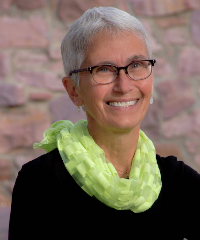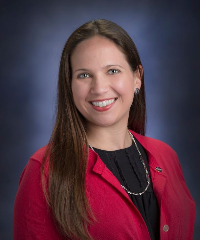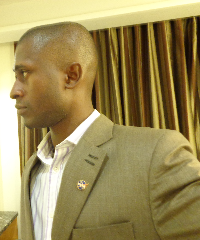GISN & STEM Professionals' Blog - GLOBE International STEM Network
GISN & STEM Professionals' Blog
The GISN and STEM Professional's Blog is an online collaborative effort where scientists associated with GLOBE post their thoughts, comments, and philosophies about a variety of science topics.
GLOBE strongly encourages positive and productive discussions to
further advance the scientific understanding of all involved with the
GLOBE Program.
Filter By:
Blogs List
Introduction/Theory
For my mosquito experiment, I am testing how different kinds of bait affect the number of oviposition in my trap. Different mosquito species are attracted to different habitats, natural or artificial, some of which have been changing due to climate change. Mosquitoes are the most dangerous animal in the world because of their disease transmitting abilities, so understanding their oviposition instincts could be crucial in order to prevent further spreading of dangerous diseases such as the dengue virus, malaria, or the zika virus.
Variables ...
Read More »
Posted in:
GLOBE Science Topics:
EARTH AS A SYSTEM
EARTH SYSTEM SCIENCE
Investigation Areas:
HYDROSPHERE
EARTH AS A SYSTEM
MOSQUITOES
Primary Audience:
STUDENTS
TEACHERS
Student Research Reports:
INTERNATIONAL VIRTUAL SCIENCE SYMPOSIUM REPORT
MISSION MOSQUITO REPORT
Research Questions: My experiment ran two adjacent triads of mosquito traps aimed to explore two questions: whether the local mosquito species in my area prefer to oviposit in containers with greater surface areas of water, and whether the same mosquitoes would prefer to oviposit in particular containers with varying types of water "bait".
Data: After 5 weeks of running this experiment, I failed to capture even a single mosquito larva. I'll go into further depth as to why this might've been later on in the "Conclusion" section. Both experiments suffered from a ...
Posted in:
Curriculum:
STEM
GLOBE Science Topics:
EARTH AS A SYSTEM
EARTH SYSTEM SCIENCE
Investigation Areas:
EARTH AS A SYSTEM
MOSQUITOES
Primary Audience:
STUDENTS
TEACHERS
Student Research Reports:
INTERNATIONAL VIRTUAL SCIENCE SYMPOSIUM REPORT
MISSION MOSQUITO REPORT
During my field study, I observed that I found more mosquito larvae in dirty ditches under an open sky. Based on my observations, for my mosquito traps, the specific variables I chose to control were centered around the quality of water and trap wall materials. I made 3 traps: A deep ceramic pot with mud, water, sticks, and dead and live plants, a cut water bottle with clear water and black electrical tape wrapped around it, and a shallow, wide plastic dish filled with water and dead vegetation but relatively little other particulates.
1. Pot trap with ...
Posted in:
GLOBE Science Topics:
EARTH AS A SYSTEM
EARTH SYSTEM SCIENCE
Investigation Areas:
HYDROSPHERE
MOSQUITOES
Primary Audience:
STUDENTS
TEACHERS
Student Research Reports:
INTERNATIONAL VIRTUAL SCIENCE SYMPOSIUM REPORT
MISSION MOSQUITO REPORT
*Last Updated July 14, 2022
Purpose: For my experiment, I am testing what color container and type of water mosquitos are most attracted to.
Background research: During the weekly science session with Dr. Alison Parker, I learned more about mosquito habitats and where mosquitos breed. Mosquitos lay their eggs in/near water, and mosquitos in their early larvae and pupae stages live in water. This information guided me to choose my AOI coordinates in an area with standing water. The coordinates on the red line in the picture run along a ditch that leads into a ...
Posted in:
Curriculum:
STEM
GLOBE Science Topics:
EARTH AS A SYSTEM
Investigation Areas:
EARTH AS A SYSTEM
MOSQUITOES
Primary Audience:
STUDENTS
TEACHERS
I am currently testing the attractability of mosquitoes to black and white, with a control of transparent plastic. This could help us determine what clothes to dress in to avoid mosquito bites, and therefore the spread of disease, when going outside.
Materials:
Three 1 liter clear plastic containers
One 1 liter white plastic container
One 1 liter black plastic container
Five wooden sticks
Fish food
Hypothesis: Mosquitoes will hatch more larvae inside of a white conatiner than a Black container because the white stands out more in a natural environment.
I ...
Posted in:
GLOBE Science Topics:
GLOBE PROTOCOLS
EARTH AS A SYSTEM
EARTH SYSTEM SCIENCE
Investigation Areas:
EARTH AS A SYSTEM
MOSQUITOES
Primary Audience:
STUDENTS
TEACHERS
Student Research Reports:
INTERNATIONAL VIRTUAL SCIENCE SYMPOSIUM REPORT
MISSION MOSQUITO REPORT
Conclusion: Although no mosquitoes were found, this process has helped me understand the methodology of making an experiment and having to deal with hardships and setbacks. There were many potential sources of error both within the system of the experiment and with outside forces. Systematic errors could have stemmed from the trap design or location. The weather was a factor of random error. The weather varied across the duration of the experiment, sometimes drastically within a single week. The weather changes could have been counteracted with more frequent checking of the ...
Posted in:
GLOBE Science Topics:
EARTH AS A SYSTEM
EARTH SYSTEM SCIENCE
Investigation Areas:
HYDROSPHERE
MOSQUITOES
Primary Audience:
STUDENTS
TEACHERS
Student Research Reports:
INTERNATIONAL VIRTUAL SCIENCE SYMPOSIUM REPORT
MISSION MOSQUITO REPORT
I currently have four traps in operational order. Two at one of my AOIs and two in backyard that were prototypes that I've left up because they seem to be performing admirably. I My traps have been up for about a week, the prototypes were deployed a day before the other two, and I haven't seen any mosquitos or mosquito larvae. I did take care to note that I used dog food in my trap, specifically the dry kibble variant instead of ones that come in chunks or are wet. I choose dog food over decomposed plant-based organic material because I noticed that the few times I've accidentally ...
Posted in:
GLOBE Science Topics:
EARTH AS A SYSTEM
EARTH SYSTEM SCIENCE
Investigation Areas:
EARTH AS A SYSTEM
MOSQUITOES
Primary Audience:
STUDENTS
TEACHERS
Student Research Reports:
INTERNATIONAL VIRTUAL SCIENCE SYMPOSIUM REPORT
MISSION MOSQUITO REPORT
The NASA GLOBE Clouds Quarterly Update is available for September/October/November 2022!
Match to a Million Satellite Matches Celebration
Thanks to you, The GLOBE Program has reached one million satellite observations matched to your cloud reports! Share in the celebration and thank you videos made just for you.
GLOBE Clouds New Satellite Matching: NOAA-20
The NASA GLOBE Clouds team will soon be adding NOAA-20 to our satellite matching capabilities. Learn more about NOAA-20 and updates to the GLOBE Clouds satellite matching schedule.
Meet an Expert: Naudia Graham ...
Posted in:
Curriculum:
SCIENCE AND MATH
GLOBE International STEM Network (GISN):
GLOBE INTERNATIONAL STEM NETWORK (GISN)
GLOBE Science Topics:
BACKYARD SCIENCE
CLIMATE
CLIMATE CHANGE
GLOBE PROTOCOLS
EARTH AS A SYSTEM
Investigation Areas:
ATMOSPHERE
CLOUDS
My involvement in the Stem Enhancement in Earth Science (SEES) program started sometime around early spring 2021. The involvement was preceded by a strong recommendation from Dr. Kevin Czajkowski, PI, GLOBE Mission Earth, The University of Toledo.
Indeed, to me as a member of the GLOBE International STEM Network (GISN), my participation in SEES became an opportunity to invoke the GISN mandate which includes to mentor and inspiring ...
Posted in:
Curriculum:
ASSESSMENT AND EVALUATION
EDUCATION RESEARCH
SCIENCE AND MATH
TECHNOLOGY
STEM
Field Campaigns:
WATERSHEDS
SMAP
SURFACE TEMPERATURE
GPM
GLOBE Science Topics:
EARTH AS A SYSTEM
Investigation Areas:
ATMOSPHERE
HYDROSPHERE
PEDOSPHERE (SOIL)
BIOSPHERE
Learning Activities:
EARTH AS A SYSTEM
Primary Audience:
PARTNERS
SCIENTISTS
STUDENTS
Did you know that clouds can both warm and cool our planet? Keeping an eye on clouds helps NASA study our climate. You can notice some of these changes by just looking at the clouds.
Here are some examples you might have already noticed:
Do all clouds cast shadows? Low thick clouds tend to cast the most shadows. The shadows show you how the cloud is blocking the light from the sun from reaching the ground. This is similar to you placing your hand in front of your eyes when it is too sunny. Your hand is blocking the light from reaching your eyes. This is the same as the ...
Posted in:
Curriculum:
SCIENCE AND MATH
STEM
GLOBE Science Topics:
BACKYARD SCIENCE
CLIMATE
CLIMATE CHANGE
GENERAL SCIENCE
GLOBE PROTOCOLS
EARTH AS A SYSTEM
SCIENTIST SKILLS
Investigation Areas:
ATMOSPHERE
Primary Audience:
ALUMNI
COUNTRY COORDINATORS
PARTNERS
SCIENTISTS
STUDENTS
TEACHERS
TRAINERS
Background
Remote working and remote learning presented challenges to
us all. As a Master Trainer in Colombia, Juan Felipe Restrepo Mesa
faced and overcame his share of challenges when working with a new
group of educators from rural areas. Most of the training material
and the tests that need to be answered were in English. This, of
course, means that citizen scientists who do not speak English were
prevented from making their contributions living in those areas where
GLOBE Observer Mosquito Habitat Mapper's contributions are essential.
Juan Felipe had to set up a MEET ...
Posted in:
GLOBE Science Topics:
EARTH AS A SYSTEM
EARTH SYSTEM SCIENCE
Investigation Areas:
HYDROSPHERE
LAND COVER CLASSIFICATION
MOSQUITOES
Primary Audience:
COUNTRY COORDINATORS
PARTNERS
SCIENTISTS
TEACHERS
TRAINERS
Every time you take a cloud observation, the NASA GLOBE Clouds team matches your observation to satellite data. Why do we do this? Your view of clouds is from a different perspective than what is observed from a satellite. Satellites look down at clouds and see the top. When you make your observation, you are looking up towards the sky and seeing the bottom of the clouds. When there is a match, scientists then have a top-down view of clouds from a satellite and a bottom-up view from your spot. When you mix these two views together, you have a more complete picture of the sky. ...
Posted in:
Curriculum:
EDUCATION RESEARCH
SCIENCE AND MATH
STEM
GLOBE Science Topics:
BACKYARD SCIENCE
CLIMATE
CLIMATE CHANGE
DATA INCLUDED
GENERAL SCIENCE
GLOBE PROTOCOLS
EARTH AS A SYSTEM
EARTH SYSTEM SCIENCE
SCIENTIST SKILLS
Investigation Areas:
ATMOSPHERE
EARTH AS A SYSTEM
News Topics:
REGIONS
Primary Audience:
ALUMNI
COUNTRY COORDINATORS
PARTNERS
SCIENTISTS
STUDENTS
TEACHERS
TRAINERS
The NASA GLOBE Clouds team highlights cloud observers Hilde Fålun Strøm (Norway) and Sunniva Sorby (Canada), who created Hearts In The Ice to call attention to all the rapid changes occurring in the polar regions due to the changing climate. These citizen scientists made history last year by being the first women to overwinter solo in the high Arctic. They spent 12 consecutive months without running water or electricity at a remote trappers cabin called “Bamsebu” in Svalbard, Norway. While they were there, they made numerous GLOBE cloud observations as ...
Posted in:
Curriculum:
LANGUAGE CULTURE AND ARTS
STEM
GLOBE Science Topics:
BACKYARD SCIENCE
CLIMATE
CLIMATE CHANGE
DATA INCLUDED
GENERAL SCIENCE
EARTH AS A SYSTEM
EARTH SYSTEM SCIENCE
SCIENTIST SKILLS
GLOBE Working Groups:
SCIENCE WORKING GROUP
EDUCATION WORKING GROUP
Investigation Areas:
ATMOSPHERE
EARTH AS A SYSTEM
News Topics:
COMMUNITY LETTERS
NEWS BRIEFS
Primary Audience:
ALUMNI
COUNTRY COORDINATORS
PARTNERS
SCIENTISTS
STUDENTS
TEACHERS
TRAINERS
The NASA GLOBE Clouds team is continuously working with scientists around the world finding ways that cloud observations from citizen scientists impact the most. As we find new ways of using the data, we want to remind you how important each part of your cloud report is to the scientific community. All cloud observations can help with big questions such as the link between clouds and climate. Dr. Patrick Taylor is an atmospheric scientist at NASA Langley Research Center in Hampton, Virginia. In the Clouds and Earth’s Climate video , Patrick discusses how he studies clouds to ...
Posted in:
Curriculum:
ASSESSMENT AND EVALUATION
EDUCATION RESEARCH
SCIENCE AND MATH
STEM
GLOBE Science Topics:
BACKYARD SCIENCE
CLIMATE
CLIMATE CHANGE
GENERAL SCIENCE
GLOBE PROTOCOLS
EARTH AS A SYSTEM
EARTH SYSTEM SCIENCE
SCIENTIST SKILLS
GLOBE Working Groups:
SCIENCE WORKING GROUP
EDUCATION WORKING GROUP
Investigation Areas:
ATMOSPHERE
EARTH AS A SYSTEM
Learning Activities:
ATMOSPHERE AND CLIMATE
News Topics:
COMMUNITY LETTERS
NEWS BRIEFS
Primary Audience:
ALUMNI
COUNTRY COORDINATORS
PARTNERS
SCIENTISTS
STUDENTS
TEACHERS
TRAINERS
Student Research Reports:
STANDARD RESEARCH REPORT
Teacher's Guide:
INVESTIGATION AREA DOCUMENTS
Each cloud observation submitted using the GLOBE Observer app or through The GLOBE Program is compared to data from multiple satellites. A satellite match is when satellite data is identified that corresponds to a cloud observation. For orbiting satellites the observation must be within 15 minutes before or after a satellite’s overpass. Geostationary satellites, like the GOES satellites, are always observing the same location. If you are in the United States, you are likely to get a satellite match to a GOES satellite. These satellites are sending data every 15 minutes. As long ...
Posted in:
Curriculum:
SCIENCE AND MATH
STEM
GLOBE Science Topics:
BACKYARD SCIENCE
CLIMATE
GENERAL SCIENCE
GLOBE PROTOCOLS
EARTH AS A SYSTEM
EARTH SYSTEM SCIENCE
SCIENTIST SKILLS
Investigation Areas:
ATMOSPHERE
EARTH AS A SYSTEM
News Topics:
COMMUNITY LETTERS
NEWS BRIEFS
Primary Audience:
ALUMNI
COUNTRY COORDINATORS
PARTNERS
SCIENTISTS
STUDENTS
TEACHERS
TRAINERS
The NASA GLOBE Clouds team at NASA Langley Research Center is working with NASA scientist Dr. Bill Smith to use GLOBE Cloud observations made by people just like you to solve the Terminator Problem!
Wait, what? Well, the Solar Terminator or twilight zone is that line that separates the daylit side of a planet from the dark night side. The image on the left is an example. It was taken from the International Space Station as it crossed the terminator on April 17, 2019 as it orbits 254 miles above the Gulf of Guinea on Africa’s mid-western coast.
...
Posted in:
Curriculum:
EDUCATION RESEARCH
SCIENCE AND MATH
TECHNOLOGY
STEM
GLOBE Science Topics:
BACKYARD SCIENCE
CLIMATE
CLIMATE CHANGE
DATA INCLUDED
GENERAL SCIENCE
GLOBE PROTOCOLS
EARTH AS A SYSTEM
EARTH SYSTEM SCIENCE
SCIENTIST SKILLS
Investigation Areas:
ATMOSPHERE
EARTH AS A SYSTEM
Learning Activities:
ATMOSPHERE AND CLIMATE
EARTH AS A SYSTEM
News Topics:
COMMUNITY LETTERS
NEWS BRIEFS
Student Research Reports:
STANDARD RESEARCH REPORT
INTERNATIONAL VIRTUAL SCIENCE SYMPOSIUM REPORT
U.S. STUDENT RESEARCH SYMPOSIA (SRS)
Santa Fe Indian School Café Scientifique presents Marilé Colón Robles, a NASA scientists to share how you can become a citizen scientist and help NASA
Learn how to do cloud observations with: Marilé Colón Robles, Project Scientist for NASA Globe Clouds
CLICK HERE TO REGISTER
Café Descriptio n:
Marilé Colón Robles, Project Scientist for NASA GLOBE Clouds Science Systems and Applications, Inc. will be presenting information about cloud and aerosol data that NASA uses and how you as a citizen scientist can help in the collection of this data.
Please register to the event ...
Posted in:
Curriculum:
EDUCATION RESEARCH
LANGUAGE CULTURE AND ARTS
SCIENCE AND MATH
STEM
GLOBE Science Topics:
BACKYARD SCIENCE
CLIMATE
CLIMATE CHANGE
GENERAL SCIENCE
EARTH AS A SYSTEM
EARTH SYSTEM SCIENCE
SCIENTIST SKILLS
Learning Activities:
ATMOSPHERE AND CLIMATE
News Topics:
CALENDAR
Primary Audience:
STUDENTS
septiembre/octubre/noviembre 2020
Nuevos recursos disponibles
Gracias a nuestra comunidad de nubes, el reto comunitario de nubes 2020 fue un gran éxito al mostrar cómo la ciencia es mejor juntos. Recibimos excelentes fotografías y obras de artes de los participantes, algunas de las cuales se destacaron en el video de agradecimiento.
Si no pudistes participar del reto o quieres seguir trabajando en él, visita la página de la guía para familias de nubes GLOBE para obtener los recursos. Encontrarás vídeos sobre la ciencias de nubes (inglés) y ...
Posted in:
Curriculum:
STEM
EDUCATION RESEARCH
SCIENCE AND MATH
Event Topics:
CAMPAIGNS AND PROJECTS (IOPS, ETC)
OTHER
COMPETITIONS
GLOBE Science Topics:
EARTH SYSTEM SCIENCE
GENERAL SCIENCE
GENERAL SCIENCE @ES
CLIMATE CHANGE
DATA INCLUDED
BACKYARD SCIENCE
CLIMATE
EARTH AS A SYSTEM
SCIENTIST SKILLS
GLOBE PROTOCOLS
Investigation Areas:
ATMOSPHERE
EARTH AS A SYSTEM
Learning Activities:
EARTH AS A SYSTEM
ATMOSPHERE AND CLIMATE
News Topics:
COMMUNITY LETTERS
Primary Audience:
PARTNERS
SCIENTISTS
ALUMNI
COUNTRY COORDINATORS
TRAINERS
TEACHERS
STUDENTS
Student Research Reports:
U.S. STUDENT RESEARCH SYMPOSIA (SRS)
INTERNATIONAL VIRTUAL SCIENCE SYMPOSIUM REPORT
STANDARD RESEARCH REPORT
September/October/November 2020
Cloud Challenge Resources Available
Thanks to our cloud community, the 2020 Community Cloud Challenge was a great success showing how Science is Better Together! We received some great photos and artwork from participants, some of which were highlighted in the thank you video .
If you missed the challenge or want to keep working on it, visit the GLOBE Clouds Family Guide page for the resources. You will find videos about the Science of Clouds and the Family Cloud Challenge page with a Choice ...
Posted in:
Curriculum:
STEM
EDUCATION RESEARCH
SCIENCE AND MATH
Event Topics:
CAMPAIGNS AND PROJECTS (IOPS, ETC)
OTHER
GLOBE Science Topics:
EARTH SYSTEM SCIENCE
GENERAL SCIENCE
GENERAL SCIENCE @ES
CLIMATE CHANGE
DATA INCLUDED
BACKYARD SCIENCE
CLIMATE
EARTH AS A SYSTEM
SCIENTIST SKILLS
GLOBE PROTOCOLS
GLOBE Working Groups:
EVALUATION WORKING GROUP
EDUCATION WORKING GROUP
TECHNOLOGY WORKING GROUP
SCIENCE WORKING GROUP
Investigation Areas:
ATMOSPHERE
EARTH AS A SYSTEM
Learning Activities:
EARTH AS A SYSTEM
ATMOSPHERE AND CLIMATE
News Topics:
IOPS
REGIONS
COMMUNITY LETTERS
NEWS BRIEFS
Primary Audience:
PARTNERS
SCIENTISTS
ALUMNI
COUNTRY COORDINATORS
TRAINERS
TEACHERS
STUDENTS
Student Research Reports:
INTERNATIONAL VIRTUAL SCIENCE SYMPOSIUM REPORT
STANDARD RESEARCH REPORT
The NASA GLOBE Clouds team never imagined this time last year that we'd be holding our GLOBE 2020 Community Cloud Challenge in the midst of a global pandemic. But GLOBE is about community and showing how science is better together!
In the four weeks of the challenge, we had the opportunity to learn how eight different NASA scientists study clouds to better understand our atmosphere and the important role citizen science observations play in that. You also had the chance to learn about cloud-related activities from six different amazing GLOBE educators.
And ...
Posted in:
Curriculum:
STEM
EDUCATION RESEARCH
SCIENCE AND MATH
TECHNOLOGY
Event Topics:
CAMPAIGNS AND PROJECTS (IOPS, ETC)
OTHER
COMPETITIONS
GLOBE Science Topics:
EARTH SYSTEM SCIENCE
GENERAL SCIENCE
GENERAL SCIENCE @ES
DATA INCLUDED
BACKYARD SCIENCE
CLIMATE
EARTH AS A SYSTEM
GLOBE PROTOCOLS
SCIENTIST SKILLS
GLOBE Working Groups:
EVALUATION WORKING GROUP
EDUCATION WORKING GROUP
TECHNOLOGY WORKING GROUP
SCIENCE WORKING GROUP
Investigation Areas:
ATMOSPHERE
EARTH AS A SYSTEM
Learning Activities:
EARTH AS A SYSTEM
ATMOSPHERE AND CLIMATE
News Topics:
IOPS
Primary Audience:
PARTNERS
SCIENTISTS
ALUMNI
COUNTRY COORDINATORS
TRAINERS
STUDENTS
TEACHERS
Student Research Reports:
STANDARD RESEARCH REPORT
—
20 Items per Page








